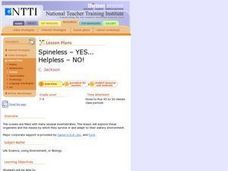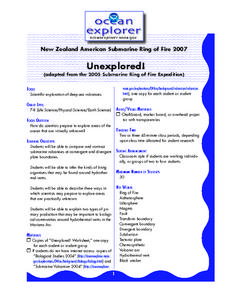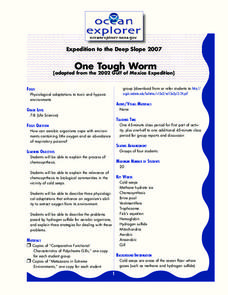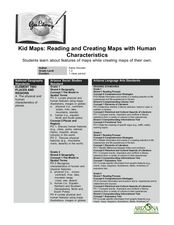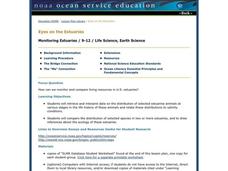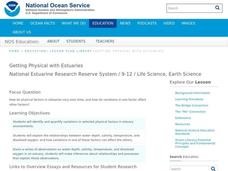Curated OER
The Exploration Age
Students discover information about the early explorers. In this Exploration Age instructional activity, students watch "The Great Age of Exploration'" and respond to the provided questions about the video.
Curated OER
Small Wonders
Pupils investigate some of the 'mysteries' of the animal, marine and insect worlds, and create student books explaining their findings to younger students.
Curated OER
2005 Submarine Ring of Fire Expedition: What's for Dinner?
Students compare and contrast photosynthesis and chemosynthesis as sources of primary production for biological communities, and describe sources of primary production observed in biological communities associated with volcanoes of the...
Curated OER
The Moon Made Me Do It!
Students research lunar cycles and how it effects living organisms. In this investigative lesson students prepare written reports on the lunar cycles and the relationship between animal behavior and reproductivity then give an oral...
Curated OER
Spineless - YES... Helpless - NO!
Young scholars distinguish between invertebrate and vertebrate organisms while examining the zoological classes of a number of invertebrates. They illustrate a food web of these organisms and investigate the impact of humans on the...
Curated OER
Unexplored!
Students explore volcanoes. In this deep sea volcano instructional activity students complete a worksheet and various activities.
Curated OER
One Tough Worm
Students explain the process of chemosynthesis and its relevance to biological communities. In this investigative lesson students discuss chemosynthetic communities, then in groups they are assigned a species and are to calculate the gas...
Curated OER
Unit 5 - Food
Learners study the biodiversity existing in the Amazon rainforest. In this Amazon biodiversity lesson, students study diagrams, maps, and information about the biodiversity in the Amazon.
Curated OER
Monsters of the Deep
Students describe major features of cold seep communities and list the organisms that are typical in these communities. In this deep sea environment lesson students work in groups and research their given cold seep group.
Curated OER
Kid Maps: Reading and Creating Maps with Human Characteristics
Students look at maps. In this map lesson, students listen to the book My Map Book by Sara Fanelli and they see the difference between human characteristics (buildings, etc.) and natural characteristics (rivers, etc.). They...
Curated OER
Save the Bay
Students explore the concept of environmental stewardship. In this science instructional activity, students examine the environmental effects of oil spills as they replicate a contained oil spill and clean up.
Curated OER
Hawaiian Hot Spots
Students describe how plate tectonics contribute to the development of volcanoes. In this earth science lesson, students examine the map of Hawaii and explore the physical and biological environment there. They write a story about an...
Curated OER
Starfish Project
Young scholars discuss ocean waters, tides, tide pools and the animals which live in the tide pools. They practice the push and pull method with a chink of clay to create a starfish from clay. They apply texture and decorate the...
Curated OER
Sea Activities
Students explore the sea. In this biology lesson plan, student investigate sea creatures, and sea water. Students discover how to convert sea water into fresh drinking water as well.
Curated OER
The Environments of Big Sur:Which Do We Protect?
Learners examine the California environments. In this environmental lesson, students examine the various ecosystems of California, creating a presentation on how these environments impact Big Sur. They write a paper defending their point...
Curated OER
Shipwreck Alley
High schoolers examine the different types of vessels used in commercial shipping. In this commercial shipping lesson students apply force and motion to problems of marine safety.
Curated OER
Arctic cleanup
Ninth graders examine pollution problems and how it affects the community. In this arctic cleanup lesson students study ocean currents and how they affect pollution.
Curated OER
Who Has the Light?
Students study ways in which the ability to produce light may be useful to deep-sea organisms. In groups, they research and present to the rest of the class, how a specific organism is able to produce bioluminescence.
Curated OER
The Environments of Big Sur -- Which Do We Protect?
Students investigate the geological, climatic, and biological features of Big Sur. They watch a video, conduct Internet research, and create a script and images in the form of an outline in a simulation of an environmental group.
Curated OER
Literature of the Islands and the Sea
Students read an age-appropriate novel in which an island setting plays an important role from a provided list. This will help them understand life on an island. They will analyze the plot, theme, characterization, setting, and style...
Curated OER
All Hands on Deck: A Harbor Education Program
Students build a model of an estuary. In this wetland lesson, students build a model estuary with a paint tray and modeling clay. They use the model to illustrate the impact of non-point pollution on the watershed.
Curated OER
Biomimicry: Working Together, Cooperative Design
Students explore the concept of biomimicry. In this cooperative design lesson, students consider how cooperation is connected to nature and then collaborate to create their own cooperative designs for the future.
Curated OER
Eyes on the Estuaries
Students study estuaries and compare several ones in the U.S. In this estuary lesson students interpret data and compare the distribution of different species.
Curated OER
Getting Physical with Estuaries
High schoolers study estuaries and how the physical factors change over time. In this investigative lesson students use a website to gain knowledge of estuaries then in groups they create and present their charts.






